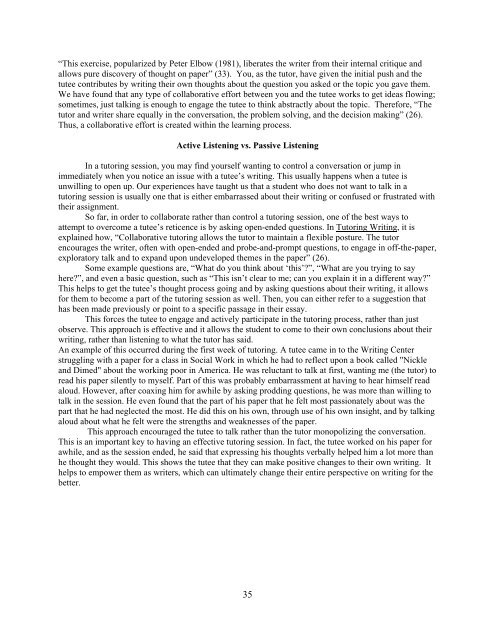The Tutoring Book - California State University, Sacramento
The Tutoring Book - California State University, Sacramento
The Tutoring Book - California State University, Sacramento
Create successful ePaper yourself
Turn your PDF publications into a flip-book with our unique Google optimized e-Paper software.
“This exercise, popularized by Peter Elbow (1981), liberates the writer from their internal critique and<br />
allows pure discovery of thought on paper” (33). You, as the tutor, have given the initial push and the<br />
tutee contributes by writing their own thoughts about the question you asked or the topic you gave them.<br />
We have found that any type of collaborative effort between you and the tutee works to get ideas flowing;<br />
sometimes, just talking is enough to engage the tutee to think abstractly about the topic. <strong>The</strong>refore, “<strong>The</strong><br />
tutor and writer share equally in the conversation, the problem solving, and the decision making” (26).<br />
Thus, a collaborative effort is created within the learning process.<br />
Active Listening vs. Passive Listening<br />
In a tutoring session, you may find yourself wanting to control a conversation or jump in<br />
immediately when you notice an issue with a tutee’s writing. This usually happens when a tutee is<br />
unwilling to open up. Our experiences have taught us that a student who does not want to talk in a<br />
tutoring session is usually one that is either embarrassed about their writing or confused or frustrated with<br />
their assignment.<br />
So far, in order to collaborate rather than control a tutoring session, one of the best ways to<br />
attempt to overcome a tutee’s reticence is by asking open-ended questions. In <strong>Tutoring</strong> Writing, it is<br />
explained how, “Collaborative tutoring allows the tutor to maintain a flexible posture. <strong>The</strong> tutor<br />
encourages the writer, often with open-ended and probe-and-prompt questions, to engage in off-the-paper,<br />
exploratory talk and to expand upon undeveloped themes in the paper” (26).<br />
Some example questions are, “What do you think about ‘this’?”, “What are you trying to say<br />
here?”, and even a basic question, such as “This isn’t clear to me; can you explain it in a different way?”<br />
This helps to get the tutee’s thought process going and by asking questions about their writing, it allows<br />
for them to become a part of the tutoring session as well. <strong>The</strong>n, you can either refer to a suggestion that<br />
has been made previously or point to a specific passage in their essay.<br />
This forces the tutee to engage and actively participate in the tutoring process, rather than just<br />
observe. This approach is effective and it allows the student to come to their own conclusions about their<br />
writing, rather than listening to what the tutor has said.<br />
An example of this occurred during the first week of tutoring. A tutee came in to the Writing Center<br />
struggling with a paper for a class in Social Work in which he had to reflect upon a book called "Nickle<br />
and Dimed" about the working poor in America. He was reluctant to talk at first, wanting me (the tutor) to<br />
read his paper silently to myself. Part of this was probably embarrassment at having to hear himself read<br />
aloud. However, after coaxing him for awhile by asking prodding questions, he was more than willing to<br />
talk in the session. He even found that the part of his paper that he felt most passionately about was the<br />
part that he had neglected the most. He did this on his own, through use of his own insight, and by talking<br />
aloud about what he felt were the strengths and weaknesses of the paper.<br />
This approach encouraged the tutee to talk rather than the tutor monopolizing the conversation.<br />
This is an important key to having an effective tutoring session. In fact, the tutee worked on his paper for<br />
awhile, and as the session ended, he said that expressing his thoughts verbally helped him a lot more than<br />
he thought they would. This shows the tutee that they can make positive changes to their own writing. It<br />
helps to empower them as writers, which can ultimately change their entire perspective on writing for the<br />
better.<br />
35

















